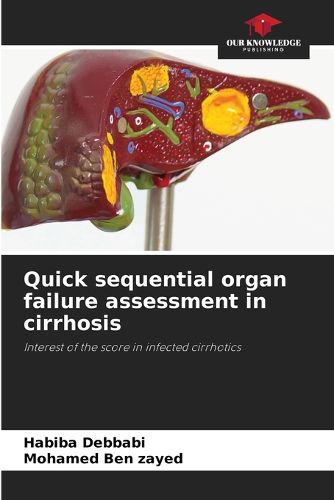Readings Newsletter
Become a Readings Member to make your shopping experience even easier.
Sign in or sign up for free!
You’re not far away from qualifying for FREE standard shipping within Australia
You’ve qualified for FREE standard shipping within Australia
The cart is loading…






This title is printed to order. This book may have been self-published. If so, we cannot guarantee the quality of the content. In the main most books will have gone through the editing process however some may not. We therefore suggest that you be aware of this before ordering this book. If in doubt check either the author or publisher’s details as we are unable to accept any returns unless they are faulty. Please contact us if you have any questions.
Materials and methods: Retrospective descriptive study including all cirrhotic patients admitted for bacterial infection to the Gastro-Hepato-enterology B Department, La Rabta over a period of 5 years. The qSOFA score was calculated retrospectively for each patient on the basis of clinical parameters collected on admission. Mortality and complications were studied over a 12-month follow-up period. Patients who were lost to follow-up and whose records could not be analysed were excluded. Similarly, cirrhotic patients who presented a second episode of bacterial infection or a complication such as HDH and/or SHR and/or HCC during the study period were excluded. Results: 61 patients were enrolled. The mean age was 63+/-12 years with a sex ratio of 0.65. Viral etiology of cirrhosis (HCV or HBV) was the predominant etiology (63.9%). The majority of patients were classified as CHILD C (50.8%) and 45.9% had a MELD > 15. UTI (42.6%) and LAI (21.3%) were the most frequent infections. BGN represented 81.3% of the germs isolated (Escherichia coli, 53.1%).
$9.00 standard shipping within Australia
FREE standard shipping within Australia for orders over $100.00
Express & International shipping calculated at checkout
Stock availability can be subject to change without notice. We recommend calling the shop or contacting our online team to check availability of low stock items. Please see our Shopping Online page for more details.
This title is printed to order. This book may have been self-published. If so, we cannot guarantee the quality of the content. In the main most books will have gone through the editing process however some may not. We therefore suggest that you be aware of this before ordering this book. If in doubt check either the author or publisher’s details as we are unable to accept any returns unless they are faulty. Please contact us if you have any questions.
Materials and methods: Retrospective descriptive study including all cirrhotic patients admitted for bacterial infection to the Gastro-Hepato-enterology B Department, La Rabta over a period of 5 years. The qSOFA score was calculated retrospectively for each patient on the basis of clinical parameters collected on admission. Mortality and complications were studied over a 12-month follow-up period. Patients who were lost to follow-up and whose records could not be analysed were excluded. Similarly, cirrhotic patients who presented a second episode of bacterial infection or a complication such as HDH and/or SHR and/or HCC during the study period were excluded. Results: 61 patients were enrolled. The mean age was 63+/-12 years with a sex ratio of 0.65. Viral etiology of cirrhosis (HCV or HBV) was the predominant etiology (63.9%). The majority of patients were classified as CHILD C (50.8%) and 45.9% had a MELD > 15. UTI (42.6%) and LAI (21.3%) were the most frequent infections. BGN represented 81.3% of the germs isolated (Escherichia coli, 53.1%).